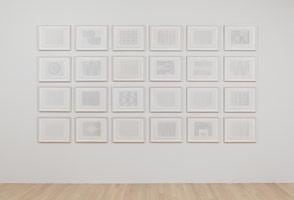
L.A. Louver is pleased to present an exhibition of computer drawings created in 1969 by Frederick Hammersley (1919-2009). Hammersley used early computer technology to make these drawings, a process that became pivotal to his artistic development.
NEW YORK, NEW YORK – AMERINGER | McENERY | YOHE is pleased to announce an exhibition of paintings by Frederick Hammersley. The exhibition will open 5 September and will remain on view through 12 October 2013. A public reception will be held 12 September from 6:00 to 8:00 PM. A fully illustrated catalogue will accompany this exhibition.
Arden Reed, in his essay for the exhibition catalogue, explains, “In order to grasp Frederick Hammersley’s paintings, you need two hands: one for his geometrics, the other for his organics.”
From 1959 to 1964 and from 1965 onwards, Hammersley produced his geometrics. The works are composed of combinations of rectangular, square, and triangular shapes that are defined by sharp angles, severe lines, and delineated areas of color.
During a brief break from the geometrics in 1964, Hammersley began work on his organics, which are defined by interlocking, free hand curves. The critic, Christopher Miles wrote that the organics are “evocative and suggestive, with elements seeming to probe and penetrate, embrace and envelop one another.”
As Reed observes, “The two bodies of work differ radically – in composition, scale, and feel – but they differ in complimentary and mutually enriching ways.” In many ways, they are more similar than different, that is the brilliance of Hammersley’s geometrics and organics – they compliment, even celebrate each other.
Hammersley first gained widespread acclaim when his paintings were featured in the landmark exhibition, “Four Abstract Classicists.” The exhibition traveled to San Francisco, London, and Belfast and was praised for its presentation of cool abstractions, which were very different from the emotional ones of the established abstract expressionist movement. From the exhibition in 1959, until his death in 2009, Hammersley spent his life committed to the development and production of distinctive, hard-edge abstractions.
Frederick Hammersley was born in Salt Lake City, Utah, in 1919. He attended the University of Idaho from 1936 to 1938 followed by the Chouinard School of Art in Los Angeles from 1940 to 1942. He served in the U.S. Army during World War II. At the end of his service, he was stationed in Paris, where he attended classes at the École des Beaux-Arts in 1945. Under the G.I. Bill, he returned to the Chouinard School of Art in 1946, and then continued his artistic studies at the Jepson Art Institute from 1947 to 1950.
He lived in Los Angeles in the 1950s. During that time, he developed his distinct “Hard-edged” technique and began associating with a small group of artists known as the Abstract Classicists. This hard-edged style made its debut in 1959 in an exhibition entitled “Four Abstract Classicists,” which included works by Hammersley, John McLaughlin, Lorser Feitelson, and Karl Benjamin. In 1968, he moved to Albuquerque, New Mexico.
His artwork may be found in the collections of the Corcoran Gallery, Washington, D.C.; the Los Angeles County Museum of Art, Los Angeles, CA; the National Gallery of Art, Washington, D.C.; the San Francisco Museum of Modern Art, San Francisco, CA; the Albright-Knox Art Gallery, Buffalo, NY; the Albuquerque Museum, Albuquerque, NM; the Baltimore Art Museum, Baltimore, MD; the Santa Barbara Museum of Art, Santa Barbara, CA; and the Oakland Museum of California, Oakland, CA, among others.
Hammersley died in Albuquerque, New Mexico in 2009.